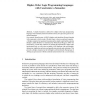662 search results - page 13 / 133 » Formalizing Basic First Order Model Theory |
MMSEC
2006
ACM
14 years 1 months ago
2006
ACM
Two different approaches for constructing a steganographic channel in an IEEE 802.11 (WLAN) network are introduced in this paper. First test results on the reliability, undetectab...
TLCA
2007
Springer
14 years 1 months ago
2007
Springer
A Kripke Semantics is defined for a higher-order logic programming language with constraints, based on Church’s Theory of Types and a generic constraint formalism. Our syntactic...
AAAI
2010
13 years 9 months ago
2010
Multi-Agent Plan Recognition (MAPR) seeks to identify the dynamic team structures and team behaviors from the observations of the activity-sequences of a set of intelligent agents...
CSCLP
2008
Springer
13 years 9 months ago
2008
Springer
Abstract. Over the last decade, first-order constraints have been efficiently used in the artificial intelligence world to model many kinds of complex problems such as: scheduling,...
ATAL
2011
Springer
12 years 7 months ago
2011
Springer
In this paper, we merge speech act theory, emotion theory, and logic. We propose a modal logic that integrates the concepts of belief, goal, ideal and responsibility and that allo...

